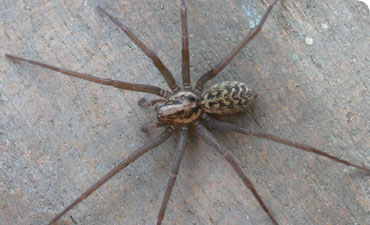House spider
The long-legged house spider pops up all over the house, especially at the end of summer.
House spider
Tegenaria species
Identification
The general appearance of an adult house spider is of a rather large, grey-brown spider that makes rapid movements on long legs. The six species of Tegenaria that are native to Britain range in size from the relatively small Tegenaria domestica to the much larger Tegenaria parietina. The latter can reach a leg span of 12.5cm (5 inches) in the adult male.
Tegenaria parietina is popularly known as the cardinal spider because Cardinal Wolsey was afraid of them at Hampton Court. The intermediate-sized Tegenaria agrestis and Tegenaria gigantea are distinguished only by microscopical details.
Distribution
Most of our species of Tegenaria were probably introduced into this country during the last few centuries among imported cargoes from the Mediterranean region. In Britain, Tegenaria house spiders are still spreading through the north of England and Scotland. Soon, few locations where there are houses will remain free of them.
The natural habitat of the spider includes caves and hollow trees but they readily adapt to buildings.
Behaviour
House spiders can be seen at all times of the year but they are most common from August to October. At this time the long-legged males reach adulthood and move around in search of females. At night they pass through open windows or under doors and many end up trapped in baths and sinks. It is a myth, however, that they enter the house via a plughole and yet another myth that they are attracted to the heat of a human body.
Tegenaria house spiders build cobwebs consisting of a silken sheet that funnels into a retreat at the back. These are long lasting structures that can attain considerable size (and dustiness!) in an undisturbed cellar, shed or garage.
Life cycle
Young spiders (resembling small versions of the adults) hatch from the egg sac and grow to maturity within a year. Males, when they become adult, are distinguished by the sex organs on the ends of the palps which look rather like a pair of boxing gloves. The males usually die in the autumn soon after mating but many females survive to the next year, during which they produce a number of egg-sacs.
Living with humans
In the UK many millions of people are bothered by the presence of Tegenaria house spiders and indeed they can bite if picked up. Although these spiders are most numerous in outbuildings such as garages or sheds, they move around at night, especially between August and October, and enter living rooms through open windows and gaps around doors. The remedy is to stop them entering by closing windows and blocking gaps with plaster. Draught excluders and insect screens for doors and windows can also help.
Fumigating living rooms to get rid of spiders is likely to be a waste of time and money because the effects are purely temporary. As yet, nobody has invented an effective device for deterring spiders.
Toolbox

With our shark experts, Speedo developed a super-fast swimsuit – its special fabric mimics the microscopic features of sharks’ skin.
